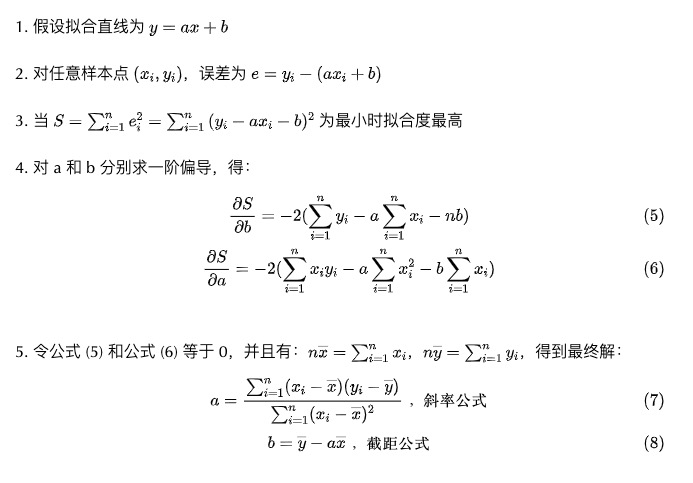回顾最小二乘法
Table of Contents
最小二乘法的用途
最小二乘法来常常用来估计线性回归中的斜率,以作线性最小二乘拟合 linear least squares fit
res = ys - (inter + slope * xs)res: 残差
ys: 因变量序列
xs: 自变量序列
inter: 截距
slope: 斜率
最好是找到合适的 inter 和 slope 使残差的绝对值最小,常见的做法是使得残差的平方和最小, 因为平方和与残差的正负值无关,并使较大的残差具有更多的权重。
···
sum(res**2)
···
最小二乘法说明
具体算法参见 https://en.wikipedia.org/wiki/Numerical_methods_for_linear_least_square
和 https://zh.wikipedia.org/wiki/%E6%9C%80%E5%B0%8F%E4%BA%8C%E4%B9%98%E6%B3%95

线性函数模型
Q = \sum_{i=1}^{n} \ [y_i - f(\vec{x}_i;\hat{\vec{\beta}})]^2y = \beta_0 + \beta_1x + \varepsilon \, .Q = \sum_{i=1}^{n} \ [y_i - (\hat{\beta}_0 + \hat{\beta}_1x_i)]^2 \, .1) taking partial derivatives of Q with respect to β0^ and β̂ 1,
2) setting each partial derivative equal to zero, and
3) solving the resulting system of two equations with two unknowns
\hat{\beta}_1 = \frac{\sum_{i=1}^{n} (x_i-\bar{x})(y_i-\bar{y})}{\sum_{i=1}^{n} (x_i-\bar{x})^2}\hat{\beta}_0 = \bar{y} - \hat{\beta}_1\bar{x}示例代码
Think stats 这本书中给了 python 的实现
参见 https://github.com/AllenDowney/ThinkStats2/blob/master/thinkstats2/thinkstats2.py
代码片段如下
def LeastSquares(xs, ys):
"""Computes a linear least squares fit for ys as a function of xs.
Args:
xs: sequence of values
ys: sequence of values
Returns:
tuple of (intercept, slope)
"""
meanx, varx = MeanVar(xs)
meany = Mean(ys)
slope = Cov(xs, ys, meanx, meany) / varx
inter = meany - slope * meanx
return inter, slope
def MeanVar(xs, ddof=0):
"""Computes mean and variance.
Based on http://stackoverflow.com/questions/19391149/
numpy-mean-and-variance-from-single-function
xs: sequence of values
ddof: delta degrees of freedom
returns: pair of float, mean and var
"""
xs = np.asarray(xs)
mean = xs.mean()
s2 = Var(xs, mean, ddof)
return mean, s2
def Mean(xs):
"""Computes mean.
xs: sequence of values
returns: float mean
"""
return np.mean(xs)
def Cov(xs, ys, meanx=None, meany=None):
"""Computes Cov(X, Y).
Args:
xs: sequence of values
ys: sequence of values
meanx: optional float mean of xs
meany: optional float mean of ys
Returns:
Cov(X, Y)
"""
xs = np.asarray(xs)
ys = np.asarray(ys)
if meanx is None:
meanx = np.mean(xs)
if meany is None:
meany = np.mean(ys)
cov = np.dot(xs-meanx, ys-meany) / len(xs)
return covComments |0|
Category: 数学